|
Yeah, I thought the same thing...
a "Wamoscope?" Was it produced by the
Wham-O toy company that makes
the Hula Hoop, the Frisbee, the Super Ball, and Silly String? Wham-O was founded
in 1948, and this article appeared in a 1956 edition of Radio & Television
News magazine, so why not? Actually, Wamoscope is derived from "WAve-MOdulated
oscilloSCOPE." Developed by Sylvania Electric Products, it combined a traveling-wave
tube with a cathode ray tube in single enclosure. That enabled microwave signals
to be fed directly to the CRT for amplifications and processing. Evidently the idea
did not catch on since the market was never filled with Wamoscope sets. A
brochure for
Sylvania's 6762 Wamoscope is shown at the bottom of the page.
See also
Simplified Radar to Use "Wamoscope" from the November 1956 issue
of Popular Electronics.
The "Wamoscope" - a Picture Tube That Includes Many Functions
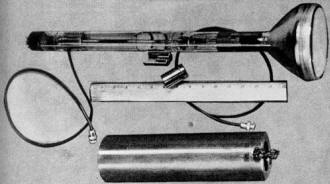
Type 6762 "Wamoscope" is shown with a 15·inch ruler to indicate
its size. Also shown is the solenoid which fits over the tube to focus it along
with the r.f. transducers.
New development combines traveling-wave tube with cathode ray tube in single
envelope. Operates in microwave range.
A radically new type of cathode ray tube for radar, television, and other electronic
display applications has been developed by Sylvania Electric Products Inc. in cooperation
with the Naval Research Laboratory. The new electronic device is called the "Wamoscope,"
from "WAve-MOdulated oscilloSCOPE."
The new tube combines most of the essential functions of a microwave receiving
set in a single tube envelope, eliminating many of the tubes and components required
by conventional receivers. In a radar receiver utilizing the "Wamoscope," microwave
signals go directly from the antenna into the tube, where, in a single envelope,
the signals are amplified, detected, and played on the tube's fluorescent screen.
Compared with a conventional radar receiver, this means that the local oscillator,
mixer, intermediate frequency amplifier, detector, video amplifier, and their associated
circuitry are eliminated. Another important feature is the wide selection of channels
possible in the "Wamoscope.' which operates over a microwave frequency band of 2000
to 4000 mc.
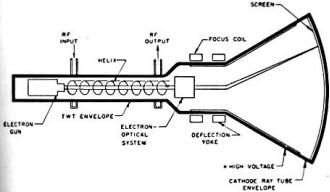
Simplified functional diagram of "Wamoscope" tube showing the
elements that operate on the electron beam. Combines traveling-wave and cathode
ray tube principles.
The operation of the tube is based upon velocity-sorting the electrons which
emerge from the end of the helix of the traveling wave tube section. A d.c. beam
is passed down the helix. With an r.f. input. the beam interacts with the r.f. fields
on the helix so that the beam is velocity and current modulated in accordance with
the amplitude of the r.f. signals. The velocity-modulated beam enters the region
where the special electron-optical system is located. By applying a suitable bias
voltage to an aperture here, the electrons whose velocity is greater than the d.c.
velocity pass through the aperture and are allowed to impinge upon the screen of
the cathode ray tube while the slower electrons are reflected.
Initial uses of the new wide-band tube will probably include special radars and
military closed-circuit television applications.
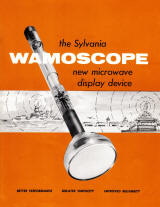 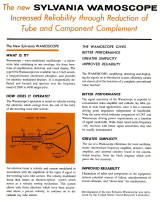 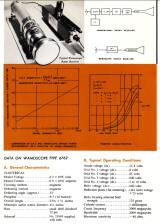 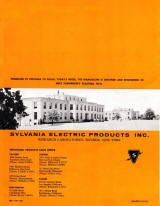
Sylvania Model 6762 Wamoscope
Posted June 16, 2020
(updated from original post on 8/2/2016)
|














